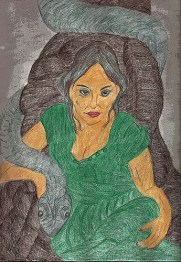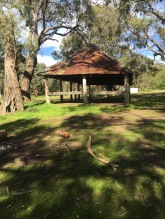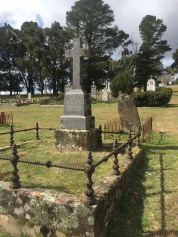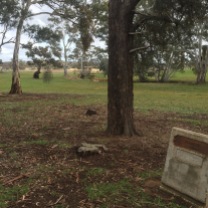The land around here is ancient. About 480 million years ago it was all under the sea. Then a couple of tectonic plates collided deep underground, squeezing everything like a vice.

I love the idea of sitting on the top of Tarrengower reading the story, as told by Justice B Nelson, and published by Culture Victoria, of two feuding volcanoes named Tarrengower and Lalgambook (Mount Franklin)
“A long, long time ago, long before anyone but the Traditional People walked our Country, our lands, rivers, mountains and animals alike, all had magical life. They had personalities, purpose, speech and they could think for themselves.
Tarrengower in the Dja Dja Wurrung means to be big and heavy and indeed he was just that; big, bold, wise and a very proud old volcano who had become very tired throwing out rocks and lava and preferred to sit humbly watching over the plains.
Another volcano called Lalgambook was a young, loud and cheeky volcano that started to challenge old Tarrengower’s wisdom and authority, and began grumbling and building up anger towards the old volcano. But Tarrengower, being the wise old volcano that he was, decided he should just try to ignore this cheeky little volcano.
Lalgambook grew even angrier that Tarrengower wasn’t acknowledging his threats and started to put on a display of smoke, ash and brimstone to impress the land and animals who were also watching, but this didn’t intimidate the wise old Tarrengower. Instead he just laughed at Lalgambook.
Lalgambook became so frustrated that he began to throw large rocks at Tarrengower who grumbled with annoyance at this cheeky volcano and Tarrengower now began to taunt young Lalgambook by telling him he wasn’t very strong at all because the rocks couldn’t reach him.
Lalgambook exploded with great fury, spurting out lava and smoke high into the sky and hurled gart gart in Tarrengower’s direction, but still could not reach him. This caused Lalgambook to completely blow his core!
Tarrengower’s anger eased and he just grumbled at this cheeky little volcano who was now just coughing and spluttering with no energy left at all.
All the rocks thrown by Lalgambook at Tarrengower can still be seen today and have formed what is known in the present day as the Guilford Plateau where the Jaara people would perform ceremonies on the Bora grounds also known as Yapene.”
Re-told by Justice B Nelson – Dja Dja Wurrung, Jaara
Content in Culture Victoria is free for educational use.
Copyright of this story
The writers, photographers and the State of Victoria
 In Game of Thrones men have maintained a watch on the wall for thousands of years. The fire tower on top of Mount Tarrengower has been consistently manned by firespotters, long term occupants of the tower, since the days of Oliver Ralph in the 1950’s. Most recently Peter Skilbeck has been on the watch!
In Game of Thrones men have maintained a watch on the wall for thousands of years. The fire tower on top of Mount Tarrengower has been consistently manned by firespotters, long term occupants of the tower, since the days of Oliver Ralph in the 1950’s. Most recently Peter Skilbeck has been on the watch!
The Advance Maldon Association brought the tower that stand on the top of Mount Tarrengower from Bendigo to Maldon to attract visitors to the area after the goldmining had almost ceased. The tower was originally the poppet legs of the Comet Mine in Bendigo, and was brought to Maldon by rail in 80′ (24m) lengths. It was carried up the mountain on a timber jinker drawn by a team of horses, along a track cut from Butts Reserve to the summit. A Mr. William Adams put up the money for the project, approx. 600 pounds. During the Maldon Easter Fair, held annually since 1877, the lookout tower is illuminated. Prior to the 1950s, this was done by wiring up over 100 makeshift lanterns, using stone ginger beer bottles, hemp wicks and kerosene. The bottles were hidden in a disused mine shaft until the next Easter.
Source: Fire Lookouts Downunder
The viewing distance from this tower is up to 100 km in all directions, except northwards to Bendigo and Mount Alexander where it is about 30 km.
Take the time to visit Mount Tarrengower and the cheeky younger volcano across the way. Learn about the spirits of volcano’s and draw upon their energy.
Volcano Folklore:
Land of Volcanoes
Merapi Volcano Spirit Keeper
Volcano Eruption Myth
Volcano Folklore
This page is only meant for educational use!

 This is a time when we can unleash and play with the Sacred Fool. The fool is a great rebel, able to thwart conventions and tell the truth without restraint.
This is a time when we can unleash and play with the Sacred Fool. The fool is a great rebel, able to thwart conventions and tell the truth without restraint. It was Grand Final Day and crowds were packing the MCG. This is the day everything seems to stop in Melbourne and the city takes on the feeling of being a ghost town as people gather in venues to watch the match. It is the day of bar-b-ques and general partying.
It was Grand Final Day and crowds were packing the MCG. This is the day everything seems to stop in Melbourne and the city takes on the feeling of being a ghost town as people gather in venues to watch the match. It is the day of bar-b-ques and general partying. The area around Bealiba was originally known as Cochrane’s, after John and James Cochrane, who took up a pastoral run in 1853. When gold was discovered in 1855-56 the area was known as Cochrane’s Diggings, but the surveyor who laid out the township in 1862 adopted the name of the pastoral run, ‘Bealaba’, later Bealiba. It is thought that the name is derived from Aboriginal words meaning red gum creek.
The area around Bealiba was originally known as Cochrane’s, after John and James Cochrane, who took up a pastoral run in 1853. When gold was discovered in 1855-56 the area was known as Cochrane’s Diggings, but the surveyor who laid out the township in 1862 adopted the name of the pastoral run, ‘Bealaba’, later Bealiba. It is thought that the name is derived from Aboriginal words meaning red gum creek. Once a hub for those seeking gold today Bealiba is a quiet little town. With nothing open to visit, I was content to go to the historic cemetery where one is inevitably confronted with the grief that people who lived in this harsh place endured. As the headstone I photographed testifies, the mortality rate amongst infants was very high. The loss endured by John and Mary Jones is hard to imagine.
Once a hub for those seeking gold today Bealiba is a quiet little town. With nothing open to visit, I was content to go to the historic cemetery where one is inevitably confronted with the grief that people who lived in this harsh place endured. As the headstone I photographed testifies, the mortality rate amongst infants was very high. The loss endured by John and Mary Jones is hard to imagine.
















 I quickly decided that blowflies are far from insignificant. They do make their presence felt! Blowflies have been deemed to be vehicles of death, decay and destruction; envoys of evil, sin and pestilence by the Christians. However, some African tribes celebrate a Fly-god, with the fly revered as an embodiment of the soul. As such flies are never killed.
I quickly decided that blowflies are far from insignificant. They do make their presence felt! Blowflies have been deemed to be vehicles of death, decay and destruction; envoys of evil, sin and pestilence by the Christians. However, some African tribes celebrate a Fly-god, with the fly revered as an embodiment of the soul. As such flies are never killed. As I sat at Dog Rocks I noted the call of the Kookaburra and the footfall of rock climbers clambering to find places to test their skills. But it was the brown butterflies who danced around me and who led me to find a small magic circle, formed by ancient granite.
As I sat at Dog Rocks I noted the call of the Kookaburra and the footfall of rock climbers clambering to find places to test their skills. But it was the brown butterflies who danced around me and who led me to find a small magic circle, formed by ancient granite.















































 I am sure you remember the Choose Your Own Adventure books, where you’re chased by a tiger. You can escape it by leaping into the ocean 50 feet below (go to page 48) or face the tiger with your homemade slingshot (go to page 128).
I am sure you remember the Choose Your Own Adventure books, where you’re chased by a tiger. You can escape it by leaping into the ocean 50 feet below (go to page 48) or face the tiger with your homemade slingshot (go to page 128).
































































 An African proverb
An African proverb














































 Margaret and Stephen Symons, of Moliagal, suffered the pain of losing their eight year old daughter in 1895. But it is likely that, the loss of their beloved son to the 1918 war, broke Margaret’s heart. She died in the same year.
Margaret and Stephen Symons, of Moliagal, suffered the pain of losing their eight year old daughter in 1895. But it is likely that, the loss of their beloved son to the 1918 war, broke Margaret’s heart. She died in the same year.



































 Since the inception of emailing and texts mail boxes around the globe have lain empty, gathering bills and cobwebs,
Since the inception of emailing and texts mail boxes around the globe have lain empty, gathering bills and cobwebs, 




 In Game of Thrones men have maintained a watch on the wall for thousands of years. The fire tower on top of Mount Tarrengower has been consistently manned by firespotters, long term occupants of the tower, since the days of Oliver Ralph in the 1950’s. Most recently Peter Skilbeck has been on the watch!
In Game of Thrones men have maintained a watch on the wall for thousands of years. The fire tower on top of Mount Tarrengower has been consistently manned by firespotters, long term occupants of the tower, since the days of Oliver Ralph in the 1950’s. Most recently Peter Skilbeck has been on the watch!










 The other stone, not far from the isolated Catholic Ground is inscribed with the words “A tribute to those who lay beneath may they have found peace”. After substantial rainfall this part of the world is truly beautiful. With only the sound of nearby grazing sheep I think it is a good place to lie and rest.
The other stone, not far from the isolated Catholic Ground is inscribed with the words “A tribute to those who lay beneath may they have found peace”. After substantial rainfall this part of the world is truly beautiful. With only the sound of nearby grazing sheep I think it is a good place to lie and rest.
